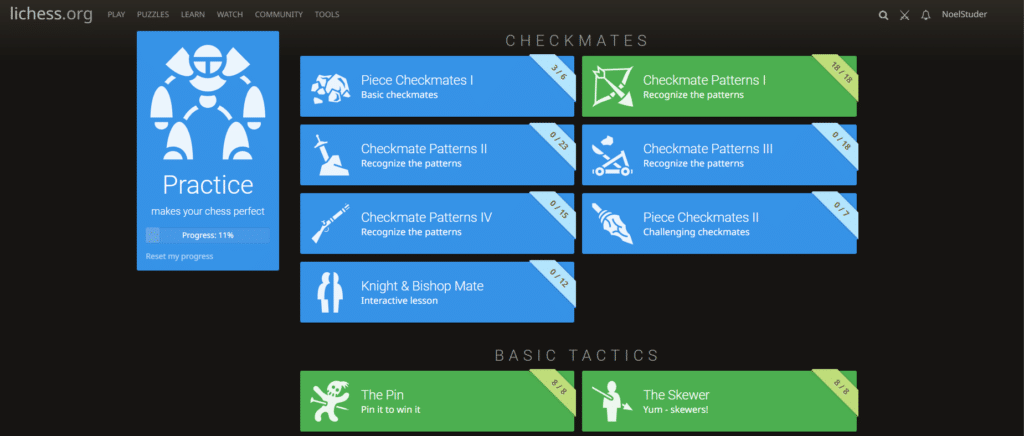Lichess is a gift to the Chess community. This free website, beloved by millions of chess fans, has so much to offer. No matter if you hear of Lichess for the first time or use it daily, this guide will help you get the most out of this amazing free platform.
I will explain in detail how you can use Lichess for the following purposes:
- Playing games (and analyzing them!)
- Learning chess basics
- Creating your own Chess databases
- Solving tactical exercises
What Is Lichess?
Lichess is a free and open-source Internet chess server run by a non-profit organization. It was founded in 2010 by French programmer Thibault Duplessis (more info on Wikipedia). Lichess has the second most traffic for chess websites after chess.com.
It has never charged a penny to its users and the site continues on the free (and ad-free!) way. All their efforts are funded by donors who enjoy the platform and want to help keep it alive. The platform offers way more than the 4 use cases I will describe in this article. To keep the article reasonably short, I decided to focus on these 4 points. Let’s start with the original use case: Playing games.
Lichess Usecase #1: Play Games
Playing games is fun. Thanks to Millions of users, you will find a suitable opponent at any time of the day on Lichess. There are four things you should keep in mind whenever you play games on Lichess so you really get the most out of it:
1) Analyze Every Game you Play!
Learning from your own games is vital. It can be overwhelming though because you don’t know where to start. As always, I strive to keep things as simple as possible! I recommend creating a study (more details later on) with all your online games. You will find an exact step-by-step manual on how to create such studies later in this article.
In order to find your own played games, just go to your profile by clicking on your username in the top right and click profile. Now you can either download all or a specific set of games by clicking the download button on the right. Or you can see your latest games by clicking on ‘games’.

The easiest way to be up to date is to download the latest games you played, insert them into your study and then start analyzing.
2) Enable Zen-Mode On Lichess
Lichess has an amazing feature called “Zen Mode” which helps you focus on your games better. Increasing your focus is vital for good chess performances, so you should use this Mode for every game you play. To enable it, click on your user name on the top right, then on preferences. You will get to the settings page.
Make sure you are on the top page of the left side called “Display”. Then, scroll down to the bottom of this page. The fourth last option is called “Zen mode”. Just click “Yes”. The next time you play a game, you will only see the following:
- The Board
- The time
You will not see any ratings, all tabs, the chat room, and other distractions.

3) Switch Off Ratings On Lichess
Focus on good moves, not on your rating! This is also made much easier by another fantastic option on Lichess. Going back to the same settings page (click on username > preferences > Display) you can again scroll down and see the last option “Show Player ratings”. Once you click “No”, all ratings will be hidden for you on Lichess.
You can still play rated games, but you want to see your own or your opponent’s rating. And neither will you find out if you won or lost rating in a given day. This allows you to focus fully on the process & playing good moves.
Obviously, you will be curious to check your rating progress from time to time. I think it is enough to check your rating on the last day of every month.
4) Avoid Tilt
Online Chess is only fun if you avoid tilt! Here is a very short guide to avoiding tilt:
- Only play Online Chess if you can focus
- Open only 1 Tab
- Never play when emotionally overwhelmed
- Set yourself a limit of games BEFORE you start playing
- Play for fun and learning. Do not play for rating gains.
For more details, check out my article on “No More Tilt”.
Lichess Usecase #2: Learning Functions On Lichess
Especially for sub-1200 players the chess basics, practice & coordinates sections are pure gold! Many don’t know that there is this great free material lying around. You can find all three under the LEARN tab on the top left. Hover over it, and you will see “Chess basics”, “Practice,” and “Coordinates” as the top 3 options.
More to number 4, Study, later on.
Chess Basics
The Chess basics section is really aimed at beginners of the game. If you aren’t sure about all the rules or would like to teach them to someone else, then this page is for you. In a playful way, you will learn all the piece movements. Then, you can learn some fundamentals by capturing pieces, defending your King, and delivering your first Checkmate in one.
Practice

This is a little bit more advanced as it requires knowledge of the rules. Now you will learn some of the basic checkmate patterns & basic tactics. Going through those is a great way to prepare to either solve tactical exercises (more to that below) or to study a more in-depth course (I recommend Tactic Ninja by Chessmood). Whenever you learn/solve anything, use your own head!
Think about the shown position BEFORE making a move. This should not be trial & error. Never make a move without writing down your own solution. More to that is in the solving tactical exercises section below.
Coordinates
If you feel like improving your overview of the Chessboard, you can drill the coordinates right here. This can be helpful to read chess books or listen to courses, for example. It can also be a fun exercise for more experienced players, just seeing how many coordinates you can get right!

I like the find Square, unlimited & Black/White options, which are the basic settings. So just click on start training and click on the Square the text is indicating. Do not spend too much time here though, because other things will improve your chess much more!
Lichess Usecase #3: Create Your Own Studies

As a professional chess player, I used the (expensive) chess program Chessbase. As a player on the national team, I always got it for free and used it to save my games, look up my opponents and create opening analyses. When I ended my career I was shocked to see that Lichess offers most of these features for free. Especially for non-professionals, Lichess offers all you need to save your games, analyze them and keep small opening files in one place.
Here is what I recommend doing: Create a study for your games, and your white & black openings. Optional studies could be created for instructive games by other players, puzzles to review, or separate studies for blitz, rapid & classical games. But whenever you start something new you should aim to keep it easy, so I recommend starting out with those mentioned above three most important ones.
Here is how you open a new study:
Hover over “Learn” and then click on “Study”. In the study section, click on the green + sign on the top right. You will see a board in the background and a pop-up “Edit Study”. Here you can decide on the settings of your study. Don’t worry, you can always change those later on.
I recommend two changes to their standard settings:
- Name → Either “my games”, “White Openings” or “Black Openings”
- Visibility → Invite only (allows you to invite Coaches, Friends, but strangers won’t be able to see your chapters)
Click save and you will get another pop-up called “New Chapter”.
If you start from 0, just give it a fitting name and click Create Chapter.
In case you already downloaded your Games, or if you have some opening files as a PGN file, you can now upload these by pasting in your PGN text or searching a file on your computer.
Your new study is now created! You can easily find your study by clicking learn > Study > my studies. If you have friends or a Chess coach you would like to share your study with, just ask them for their lichess nickname and you can share the studies with them. This is how I work with my students nowadays.
Click into the Study, then on “Member” just next to “Chapters”. Click Add Members and write the username of the person you want to invite. They can now see your study & chapters and find them more easily.
Lichess Usecase #4 Solve Tactical Exercises
“Chess is 99% tactics” Rudolf Teichmann
Albeit quite extreme, I do like this quote a lot. It just shows how important tactical vision is when you play a game of chess. You can play 50 amazing moves, maneuvering just like a Grandmaster, but if you blunder a piece (tactically!) on move 51, all the work before is in vain. And how can you get better at spotting tactics during games?
By solving tactical exercises in training.
Go to Lichess > Puzzles and you can solve as many puzzles as you like! You might find out that there are many different possibilities: Puzzle Racer, Puzzle Rush, Puzzle Survivor, Puzzle Themes…
In the beginning, I recommend keeping it simple and just doing ‘normal’ puzzles. After you click on Puzzles you will get the following setup:

Having the puzzle rated & setting the difficulty level to normal will ensure that you get the right level of puzzles. Now make sure to think first about the position. Once you seem to have found a solution, write it down somewhere (either on a Word file or with a pen on paper). Only then execute the move you believe to be the right one.
Correct? Congrats! Continue solving!
Wrong? Try again and then try to figure out why your move wasn’t the right solution. Do this consistently and your tactical vision will improve.
And your blunders will decrease!
How To Get The Most Out Of Lichess
My 4 favorite ways to get the most out of Lichess are:
- Playing & Analyzing Games
- Learning the rules, coordinates & basic motifs
- Creating your own Lichess Studies
- Solving Tactical Exercises
If you do all of them well, you can do 80% of your chess training on this amazing free online site.
Lichess rocks!
If you want to support their work, you can go to https://lichess.org/patron and donate whatever you feel like (and can afford) to keep the site going.